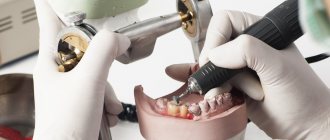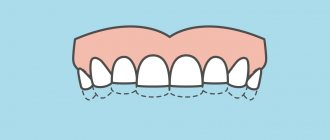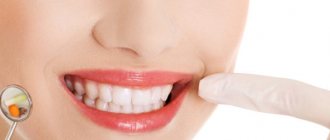Dry mouth (xerostomia) is a condition characterized by insufficient production of saliva by the salivary glands.
Dry mouth can occur from time to time: due to dehydration caused by a cold, breathing through your mouth while sleeping, stress, or a situation that makes you nervous. If dry mouth is a common symptom, it may be related to a medical condition that needs to be diagnosed and treated.
Xerostomia may be accompanied by a burning sensation in the mouth, dry throat, difficulty speaking, chewing food and swallowing, bad breath, the appearance of ulcers on the oral mucosa, dryness, flaking of the skin on the lips and the appearance of cracks on them, and dry tongue.
Causes
The causes of xerostomia include:
- medications (antibiotics, painkillers, antihistamines and antihypertensives, anticholinergics, sedatives and decongestants, muscle relaxants, antidepressants);
- age (insufficient saliva production in older people is caused by taking various medications, poor diet, and chronic diseases);
- obstructive sleep apnea syndrome;
- smoking, alcohol abuse, use of illegal substances;
- diseases: diabetes mellitus, hypothyroidism, oral candidiasis, stroke, Alzheimer's disease, Parkinson's disease, systemic lupus erythematosus, scleroderma, sarcoidosis, Sjögren's syndrome, rheumatoid arthritis, amyloidosis, HIV/AIDS;
- chemotherapy, radiation therapy (especially for head and neck tumors);
- damage to the facial nerve (trauma, surgery, Bell's palsy).
A dry mouth significantly increases the risk of tooth decay and other dental problems. Saliva helps prevent tooth decay by neutralizing acids produced by bacteria, washes away food particles, facilitates chewing and swallowing, and promotes digestion. Therefore, if xerostomia persists for a long time, it is necessary not only to eliminate its main cause, but also to make an appointment with a dentist to check the condition of the teeth and gums.
Depending on the cause, along with the manifestation of xerostomia, the following symptoms may be observed: dry and itchy eyes, dry nose, impaired sense of smell, cough, pain and stiffness in the joints, constipation, recurrent thrush (candidiasis) in women, general malaise, unexplained loss weight.
Sand in the pipes of a new building breaks equipment and grinds on teeth
Residents of one of the residential complexes in St. Petersburg are currently experiencing problems with water. In houses that were built just 2 years ago, sand literally comes out of the taps. Even after filtration, a red sediment remains in the cup, and household appliances simply cannot stand it and fail. At the same time, the management company and the water utility notice the problem, but instead of solving it, they are looking for the culprit. So who actually poured sand into the pipes, Anton Nikitin found out.
When purchasing an apartment in an old building, the buyer is a priori prepared for any municipal and everyday surprises. The same cannot be said about new buildings. People are sure that everything must be perfect here! But it was not there.
In one of the districts in St. Petersburg they sadly remember the times when residents had just moved into new apartments. Almost two years ago. But already this February the problems literally began to grind their teeth.
“The water is like this just now! Before this, the water was perfectly clean; we drank it from the tap even without a filter. Problems began in February, and work began on Parachute Street in February. There was sand, but not in such quantities; there was a finer suspension. He was walking, it was felt, by that moment. And we realized that we need to buy a water filter. Because this sand was felt on the teeth.” - says Ksenia Medvedeva, a resident of the Shuvalovsky residential complex.
Purchasing a filter for Ksenia became the most budget-friendly one. At first the tank stopped filling and draining water. Then the dishwasher broke and I had to buy a second one. The sand did not decrease, nor did the expenses. At the same time, in order not to call plumbers every day, Ksenia’s neighbor Alexandra mastered a new profession.
“I’ve already learned how to use pliers myself! And unscrew these aerators,” says Alexandra Zhukova.
Residents of the complex continue to share pictures of dirty filters, sand and simply “funny” videos on social networks. They treat what is happening with humor, even when water does not flow from the tap, but, on the contrary, disappears into it.
Social networks immediately responded to such an unusual communal phenomenon.
But when it comes to cooking or bathing, it's no laughing matter. The fine suspension in the water remains to this day. Residents believe that the accident on Parashutnaya Street is to blame. Vodokanal has its own version.
“One of the possible reasons for the deterioration in the quality of water supply in the quarter could be a violation of the technology for constructing water supply networks on the territory of the residential complex. Which could be caused by the presence of sand in the pipes. A change in the hydraulic operating mode of the networks could provoke a temporary change in the quality and traffic on the networks,” says Ilya Klimentyev, chief specialist for media relations at the State Unitary Enterprise Vodokanal of St. Petersburg.
The water utility assures that after the pipe leaked, specialists flushed all communications that were on the organization’s balance sheet. The rest is the responsibility of the management company. They answered - now we flush the pipes every night. And the water became cleaner.
The reports are all clear. But what then to call what settles in the filters, the residents of the complex wonder. This is not an isolated case - residents of Samara told the same story. The saga there began back in November.
“I feel sorry for the people, our residents, because the plumbing becomes unusable, washing machines break down, taps fail, children cannot bathe in such water, or drink at all... Well, that is, this water is unsuitable for human life,” says the chairman of the Uyut-HOA. 2 in Samara Ekaterina Smerchanskaya.
According to the lawyer, in such situations you need to start with an examination. The breakdown must be recorded.
“If the management company or water utility refuses to compensate for losses, it is necessary to contact an independent expert organization with a report on the presence of a breakdown, establish the reason for the failure of household appliances, then contact the service center and repair it yourself,” says Irina Andreeva, a lawyer at the Consumer Society of St. Petersburg.
And when it is clear whose fault water and sand are flowing from the tap, all costs can be assigned to the guilty organization.
When should you see a doctor?
It is necessary to make an appointment with a doctor if dry mouth is often bothersome, for diagnosis and treatment, if the symptom is not associated with obvious causes - smoking, alcohol abuse, stress, anxiety, etc.
The doctor will take anamnesis, study your medical history, medications you take, and conduct a physical examination. If necessary, he will prescribe laboratory diagnostics, ultrasound of the salivary glands, and conduct a special test to measure the amount of saliva produced. If Sjogren's syndrome is suspected, a biopsy from the minor salivary glands of the lower lip will be required.
Treatment for dry mouth depends on the cause. If the symptom is caused by a medication, the doctor will select a replacement drug or adjust its dosage. He may also recommend various products to moisturize the mouth, stimulate saliva production and relieve xerostomia.
Sand creaked on the teeth of Homo naledi
Discovery of Homo naledi
(1,500 remains from at least 15 individuals) is a treasure for paleoanthropologists. The flood of research into this unprecedented collection has only just begun. Now experts have taken on the teeth of amazing people from the South African Rising Star Cave. What's special about these teeth (besides their small size)? Scientists drew attention to a large number of enamel damage - small chips, which are especially common on the molars of the naledi. What caused them? If such injuries occurred during life, then their cause should have been some fairly hard objects that fell into the person’s mouth.
Read this and other anthropological news on the website Anthropogenesis.ru
Share
Share
Examples of chipped teeth of Homo naledi
I.Towle, JD.Irish, I.De Groote / Am J Phys Anthropol., 2017
Tooth enamel is pretty darn hard and can withstand forces of over 1,000 newtons. However, teeth can also be destroyed, and the nature of their damage indicates the diet and lifestyle of the owner. Chips can occur upon contact with a variety of objects - from berry seeds to seeds and nuts. In addition, teeth suffer if you eat food contaminated with sand - for example, rhizomes and tubers just dug out of the ground.
Comparing the teeth of different apes, experts noticed that orangutans have chipped chewing teeth six times more often than chimpanzees and gorillas. This is likely due to differences in diet: gorillas eat leaves, while chimpanzees prefer soft fruits. Orangutans have a diet that contains a lot of solid foods. In humans, it has been observed that among hunter-gatherers, chips predominate on the back teeth, while among farmers and herders, chips predominate on the front teeth.
What about fossil hominins? Anthropologists studied the surface of the teeth of South African Australopithecus and Paranthropus. Damage to ancient teeth has been interpreted as the result of eating rhizomes, seeds and nuts, or even chewing on bones. Chips in the enamel were also found in early East African hominids, as well as in Neanderthals.
In a new study, experts analyze chips on the permanent teeth of Homo naledi
, and the data obtained is compared with information from other fossils and modern primates (including humans).
The scientists had 156 permanent naled teeth in their hands, of which 126 were selected for analysis, discarding damaged and unerupted ones. The collection was compared with data on the teeth of Australopithecus africanus (265 samples), Paranthropus robustus (235), and extensive databases on chimpanzees, gorillas and baboons. In addition, scientists used information about seven collections of human teeth (Inuit, ancient Rome, Epipaleolithic Morocco, medieval Norway, etc.)
How was the analysis carried out? The teeth were examined under a magnifying glass, identifying intravital chips - only those damages on which traces of subsequent abrasion were visible were taken into account. The size of the chip, its position and the number of chips for each tooth were recorded.
What is the outcome of the study?
44 percent of Naledi's permanent teeth were chipped. This is more than that of other hominids of South Africa (however, let me remind you that the study used data on only two species - Africanus and Paranthropus robustus. There is no data on early Homo of South Africa. For some reason, even the teeth of Australopithecus sediba, described by the same Lee Berger. However, there is a very small collection there, because only two individuals have been properly described). There were especially many chips on naledi molars—54 percent of the molars contained such damage. This is twice as much as that of Australopithecus africanus and more than three times that of Paranthropus.
In terms of the number of damages on the teeth, the naledi have surpassed modern apes and are more likely to be similar to some historical groups of people (although the location of the chips is more reminiscent of australopithecines and baboons).
Most chips are small. The authors point out that there is more damage on the surfaces between the teeth, and also note that chips are more common on right teeth than on left ones. This pattern has already been found among ancient hominids, and experts associate it with right-handedness: ancient people brought food to their mouth and held it with their right hand.
In total, of the 12 individuals whose teeth were analyzed, chips were found in nine. However, of the three remaining individuals, two are represented by single teeth, and the teeth of the third are worn away.
Experts came to the conclusion that the naledi’s teeth were regularly seriously injured, and the reason was most likely associated with chewing some specific food. Damage of this kind is typical for life in arid areas, and also where, I quote, “ash clouds occur following volcanic eruptions” - ash probably also ends up in food. Here it is appropriate to recall baboons that live in arid areas - these primates have a lot of sand in their food. By the nature of the damage - the predominance of small chips on the back teeth - hamadryas and olive baboons resemble naledi.
And here are the human groups with which the people from Rising Star showed similarities:
- Paleo-Indians from Cape Cod (VX century AD, USA) - frequent chipping of molars (frequency 43 percent). The food contained a lot of sand, gravel and fragments of shellfish.
- Taforalt (11-12 thousand years ago, Morocco) - these ancient people regularly chewed snail shells and fruit seeds, chewed seeds and nuts. True, it is impossible to make a correct comparison with them, since it was customary for the Taforalans to remove the upper incisors.
- Finally, Vicenne Campochiaro (IV-X centuries, Italy) - sand in food again.
What exactly did they chew on naledi?
Shells, nuts, tubers? The authors announce the next study, where they promise to examine in detail the nature of wear on icing teeth. The researchers themselves are inclined towards the sand version in combination with relatively soft food. We just have to wait for a new article. Alexander Sokolov
Original text on the website Anthropogenesis.ru











